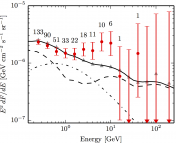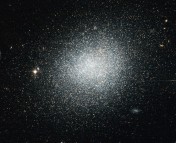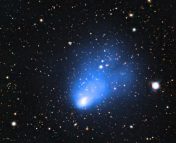Paper Title: Observations of the Missing Baryons in the Warm-Hot Intergalactic Medium
Authors: F. Nicastro, J. Kaastra, Y. Krongold, S. Borgani, E. Branchini, R. Cen, M. Dadina, C.W. Danforth, M. Elvis, F. Fiore, A. Gupta, S. Mathur, D. Mayya, F. Paerels, L. Piro, D. Rosa-Gonzalez, J. Schaye, J.M. Shull, J. Torres-Zafra, N. Wijers, L. Zappacosta
First Author’s Institution: Istituto Nazionale di Astrofisica (INAF), Osservatorio Astronomico di Roma, Rome, Italy & Harvard–Smithsonian Center for Astrophysics, Cambridge, MA, USA.
Status: Published in Nature (2018). Closed access.
When you gaze up at the night sky on a clear evening, all of the matter you observe is “baryonic”. This class of matter is primarily composed of neutrons and protons, the fundamental building blocks of atoms. In fact, all of the visible matter in the universe, including the matter the makes up you and I, is classified as baryonic matter. Surprisingly, though, this type of “normal” matter only accounts for 5% of the mass-energy in the universe; the remaining exists in the form of dark matter (25%) and dark energy (70%), which are not visible in the electromagnetic spectrum.
(Image credit: Benedikt Diemer and Phil Mansfield, University of Maryland)
Elusive Matter
Ground and space-based instrumentation should be able to effectively trace the spatial distribution of this visible baryonic matter. However, the number of baryons that have been optically observed within the universe’s large scale structures (i.e. nebulae, globular clusters, and galaxies) falls 30-40% short of what existing models predict!
To account for this discrepancy, several numerical simulations suggest that the missing baryons may be masked within hot tendrils of filamentary gas that form the cosmic web (Figure 1). Here, characteristic gas temperatures fluctuate between 100 thousand to 10 million Kelvin, which results in the ionization of hydrogen, the most abundant element within these structures. Once ionized, the hydrogen atoms cannot produce the spectral features necessary for detection in visible wavelengths since they have been stripped of their sole electron. Coupled with the inherently low density of these regions, the baryons are effectively invisible.
X-Ray Observations
To address this challenge the authors of today’s paper worked to uncover the location of the elusive reservoir of baryonic matter. They used X-ray observations, which are ideally suited to study highly energetic environments due to their short wavelength sensitivity (0.01 – 10 nanometers). Utilizing the European Space Agency’s XMM-Newton X-ray Space Telescope, they conducted nearly 20 days of observations of a blazar. These supermassive black holes generate energetic jets of ionized matter that are oriented towards Earth and can approach the speed of light. The observation of this object (1ES 1553+113) was the longest ever performed on a single target using the telescope’s spectrometer, allowing the researchers to achieve unrivaled high-resolution measurements.
The observed dynamics of the blazar itself were not what astonished the scientists; rather, the intervening matter between 1ES 1553+113 and Earth was the source of intrigue. The spectra of the blazar revealed the presence of highly ionized oxygen (OVII; Figure 2) along the external regions of the object, in an area known as the Warm-Hot Intergalactic Medium (WHIM).
The authors explain the source of this ionized metal enrichment (such as OVII) in the WHIM as coming from the blazar’s powerful outflows. The jets essentially illuminate the structure of the hidden baryons that are undetectable in visible wavelengths!
These results offer strong evidence in support of numerical models that propose baryons reside in the gaseous tendrils of the WHIM.
(Figure 1 in the paper).
Leveraging Future Instruments
However, to confirm their findings, further analysis is required. To this aim, the proposed Hot Universe Baryon Surveyor and the Advanced Telescope for High-Energy Astrophysics will be vital. These instruments will take X-ray measurements with a much higher sensitivity than the XMM-Newton and enable the researchers to better map the full distribution of baryons.
Ultimately, the observations performed by the authors offer the astrophysics community an exciting clue towards resolving the source of the missing baryons in the universe!




